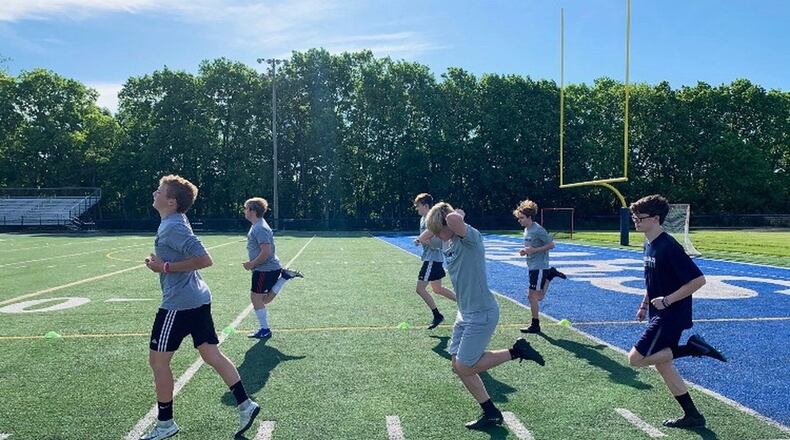Athletes from the football, girls volleyball, wrestling and boys basketball teams were among the first to enter the doors at Centerville High School, putting a smile on Athletic Director Rob Dement’s face.
“You miss the sounds,” Dement said Tuesday. “Where my office is, you can hear the kids working out.”
Return to play
Monday was the first day the Ohio High School Athletic Association allowed athletes to participate in skills training with their coaches. Many area schools opened their doors. Some are waiting until next week, such as Shawnee High School, which delayed the return of athletes because of construction at the school.
“I’m really looking forward to seeing everyone,” Shawnee AD Steve Tincher said. “It’s been like a ghost town. I miss the kids.”
Greenon High School is another Clark County school that may allow athletes to return in the second week of June.
“What we want to do as a district is obviously follow the guidelines,” football coach Josh Wooten said, “and most importantly keep our kids safe.”
The athletes and coaches who returned to action in the first week of June experienced a new world full of challenges: temperature checks at the doors; social distancing requirements on the fields and courts; an increased emphasis on the importance of washing hands, etc.
» YOUTH SPORTS: Local football organization cancels season
However, earlier in the spring, everyone expected school facilities to remain closed through the end of June, so the June 1 start date was a bonus.
“It’s been an awesome week,” Edgewood Athletic Director Greg Brown said Wednesday. “It’s been a relief for these kids mainly. You can tell they’re just eager to get after it. I don’t know if they’re quite in the shape they need to be in, but slowly and surely.”
“It was great to see kids back,” Hamilton Ross AD Jake Richards said. “My first tweet when kids showed up was, ‘Holy cow, this is awesome. This is what it’s supposed to be like.’”
Tippecanoe AD Kregg Creamer said the school was taking a conservative approach and only allowed the football and boys basketball program back on campus in the first week. Everyone else will start this Monday or the following Monday (June 15). He said Wednesday everything went well in the first three days.
“I believe that it was a toss-up between who was more excited: the kids or the coaches,” Creamer said. “Either way, everyone was extremely excited to be back on campus and just to see one another. There obviously wasn’t a lot of socialization going on, but just to bee around each other was a huge positive.”
Phase 1: first day with student athletes back on BHS campus. Cannot express how great it is to get the kiddos working out again.
— BCreek Athletics (@bcreekathletics) June 2, 2020
Thanks to our Premier Health Athletic Trainer, Kevin, for his leadership in helping us with a safe restart. Let's go!!!@CreekATC #gocreek #gobeavers pic.twitter.com/iHGJHq6wkd
Change of plans
Coaches and administrators moved fast in May to come up with plans for allowing athletes to return. The OHSAA announced May 15 it would lift the no-contact rule for baseball, golf, softball, swimming and diving, tennis and track and field on May 26, but at that time, there was still a question about whether other sports, such as football, would be able to return and if any sports would be able to start training at high school facilities.
Then on May 22, Ohio Lt. Gov. Jon Husted announced skills training in all sports could resume May 26. With that came the OHSAA’s decision to adjust its bylaws and allow coaches in the team sports of baseball, basketball, field hockey, football, ice hockey, lacrosse, soccer, softball and volleyball to work with athletes without restriction from June 1 through Aug. 31 as long as the workouts are not considered mandatory.
» GOVERNOR’S VIEWPOINT: DeWine sees sports coming back without fans
In previous years, coaches in those sports could work with athletes for a maximum of 10 days from June 1 through July 31.
“We do not want coaches to feel that they have to scramble to cover their entire program in those 10 days, an OHSAA memo read on May 22. “We want to work to make this summer safe and successful with smaller groups and social distancing being a driving force.”
With the return to training comes a set of guidelines for keeping everyone healthy and limiting the risk of spreading COVID-19. The The National Federation of State High School Associations sent guidelines to its 51 member associations on May 15, and the OHSAA molded those guidelines for its purposes.
The OHSAA plan asks schools to divide the summer into three phases with each phase offering more freedom as far as the size of groups of athletes working together.
“Every school/program should start at Phase One of this program and remain there for at least 14 calendar days,” reads an OHSAA memo. “If there is a downward/flat trajectory of documented cases within a 14-day period, a school may progress to Phase Two, where a new 14-day period of tracking of cases should begin. If there is another 14-day downward/flat trajectory of cases, schools may progress to Phase Three.”
Attention Trotwood Rams Student-Athletes & Parents. As we begin to “Return to Play” on Tuesday, June 2nd, please take time to review the guidelines. We look forward to having our players back on campus. Go Rams! pic.twitter.com/GebuqtRyWa
— Frank Russo (@CoachRussoAD) June 1, 2020
Keeping everyone safe
Trotwood-Madison AD Frank Russo said athletes would return to campus Monday, and the precautions the school will take are similar to what other schools are doing.
In phase one, they will gather in groups of 10: nine athletes and a coach. That way if anyone gets sick later, they will know who that athlete was in contact with.
“If someone in that group gets it,” said Brown, whose programs are following the same plan, “those nine individuals have to go for 14 days and self isolate instead of the entire team.”
» SUMMER BASEBALL: Prospect League cancels season
In phase two, schools can have groups of 50 in outdoor workouts, but indoor workouts still will be limited to groups of 10. In phase three, schools can have large groups indoor and outdoor.
“Coaches and athletes will have to perform a self-wellness check before they come to school,” Russo said. “Once they come to school, we’re going to meet just outside the gym, where the students will be met by a coach. Their coach will set them up in a pod, and we will bring those athletes into the gym, where they will be screened. We will ask them to sanitize their hands. All the coaches prior to that will be screened by our trainers. Anyone who has a 100.4 temperature or above will be sent home.”
Those were just a few items on a list of Return to Play guidelines. A list Russo shared on Twitter for athletes and coaches also included these points, among many others:
• No hydration station. Water will not be provided by the school.
• Students must bring their own labeled water bottle daily to workouts. Not to be shared.
• Parents must stay in their car during drop off and pick up of their children.
• Locker rooms are closed and will not be available.
• Restrooms are open at the stadium.
We’ve missed this view! What an awesome first day back in the office! Can’t wait to see the rest of you girls in the coming weeks 💛🏐 pic.twitter.com/TzEWzrJ13O
— Ross Volleyball (@rossrams_vb) June 1, 2020
Return to normalcy
At Beavercreek, athletes use their phones to scan a QR code outside the high school when they arrive. If they don’t have a phone, a coach uses a pen and paper to record their answers and then later enters the information into a shared document.
After scanning the code, a box then pops up on their phones with five health questions provided by the OHSAA. Meanwhile, a coach or trainer scans athletes’ foreheads with a thermometer.
Beavercreek AD Brad Pompos said the school district was able to acquire 30 of the non-contact digital thermometers with the help of Premier Health.
Football and volleyball athletes returned to Beavercreek’s campus Tuesday, and cross country was going to have on-campus workouts later in the week. The boys and girls basketball teams will start training Monday. Pompos said the three phases of the Return to Play plan will ease the athletes back into training and help them get ready for the fall.
“It’s been great,” Pompos said. “It was like I was back to coaching again. There was a pep in my step. We were ready to go. Just having kids on campus is a return to normalcy.”
Richards said it was important to let coaches and athletes know even though they were returning to workouts, it wouldn’t be business as usual. They can’t take the risk of letting down their guard and endangering the fall season.
“We really stressed the importance of doing this the right way,” Richards said, “and following these recommendations down to a tee. Our coaches recognize we’re going to get one shot at this. They recognize the importance of all the guidelines. Above all, something is better than nothing at this point. We were all under the impression we weren’t going to get anything until July 1 at the earliest, so to be able to start a month earlier even with the restrictions in place is kind of a welcome gift.”
About the Author

